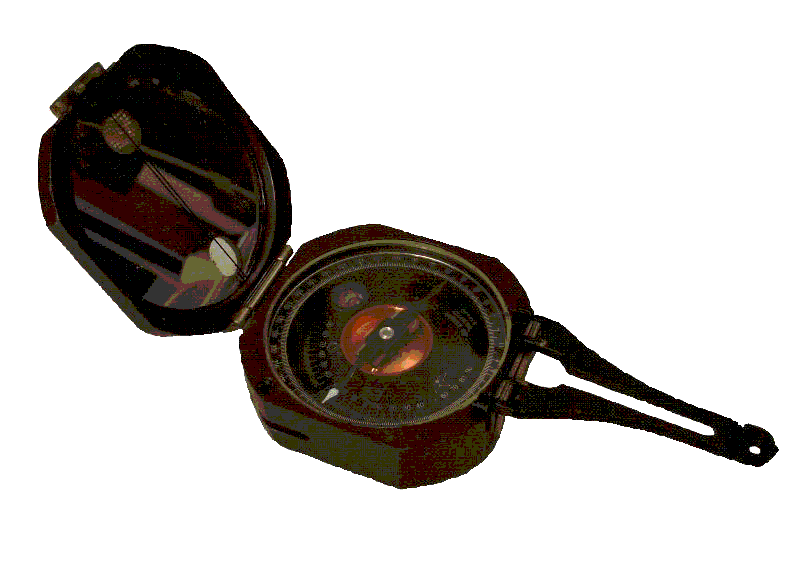|
HYDROGEOLOGIC SETTING
The
village
of Baoma is situated in a
valley near the southwest margin of the capital city of
Freetown,
Sierra Leone.
The valley floor is at an elevation of from 200 to 450 feet feet
above mean sea level (AMSL) and the surrounding ridges rise to slightly
above 1,000 feet AMSL.
Bedrock is diorite with localized lateritic weathering of bedrock.
Weathered diorite is slightly rounded and exfoliated.
The weathered, shallow laterite is tightly cemented and vesicles
are filled with breakdown residuum.
The valley floor contains some large, isolated boulders of
diorite colluvium.
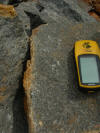


Diorite
Laterite
Large diorite boulder near Garden Spring
The PSU EWB
Chapter visited Baoma in late December 2011 through early January 2012,
which is approximately the middle of the dry season.
PSU EWB visited three local springs:
West Side, Habbour, Kamera, and
Garden Spring. PSU EWB also
visited the outflow channel from the Motema Spring and several
groundwater seeps in the former diorite quarry at the locations shown in
Figure 1

Figure 1
Groundwater
circulation occurs primarily through fractures and other secondary
porosity features in bedrock.
The diorite bedrock, as viewed in the former quarry located at
the south end of the village, is generally massive (i.e., large,
unbroken in-situ masses) with some regional jointing oriented
approximately north-south and dipping approximately 30 degrees to the
west. Several narrow
fracture zones of at least 200 feet in depth and less than 10 feet in
width were seen in the quarry wall.
Some of the exposed fracture zones discharged small amounts of
groundwater.
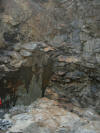
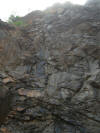
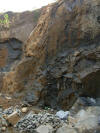
Deep seepage in Shallow seepage in
Seepage at fracture zone
brecciated diorite
fractured/brecciated
diorite
Some brecciated
(broken rock) zones were noted in the quarry at a depth of approximately
200 feet below surface.
Based upon a) the occurrence of one prominent seep near the top of the
quarry highwall and b) decreasing secondary porosity features with depth
noted in bedrock, it appears likely that the groundwater that is being
discharged at the valley wall springs (West Side, Habbour, and Kamera)
is related to flow in shallow secondary porosity features within
approximately 50 feet of the ground surface.
This shallow, weathered zone is interpreted to drain the deeper,
slower-circulating, less fractured groundwater reservoir through open
fractures and open joints.
The
West Side, Kamera, and Habbour springs all issue from vents
in diorite bedrock. At the
time of the PSU EWB visit, the flow rate of these bedrock springs was on
the order of a few gallons per minute.
All of these springs are located near the inflection point in the
valley walls between the angle of repose (approximately 20 degrees or
more slope) and the colluvial deposit at the foot of the valley walls
(less than approximately 20 degrees slope); see Figure 1.
These springs reportedly continue to discharge well into the dry
season. The geomorphic
position of these springs may be related to differential bedrock
weathering and development of secondary bedrock porosity in the upland
versus valley settings. The
low discharge rate and persistence of flow at these bedrock springs is
apparently related to limited discharge rate through secondary porosity
features and "damming" of the groundwater reservoir by
poorly-transmissive bedrock.
 The
Garden Spring issues from the contact between overlying alluvium and
underlying laterite/diorite, and was flowing at approximately 40 gpm during the
PSE EWB visit. The Garden
Spring likely receives convergent groundwater flow from a number of
fractures upslope along the valley walls.
Some flow persists at the Garden Spring throughout the dry
season. The
Garden Spring issues from the contact between overlying alluvium and
underlying laterite/diorite, and was flowing at approximately 40 gpm during the
PSE EWB visit. The Garden
Spring likely receives convergent groundwater flow from a number of
fractures upslope along the valley walls.
Some flow persists at the Garden Spring throughout the dry
season.
The spring vent of
the Motema Spring was not visited.
The Motema outflow channel was flowing at approximately 100 gpm
during the PSU EWB visit.
The chemistry of
the water at the bedrock springs and the Motema outflow channel is very
similar: very low specific
conductance (approximately 50 umhos/cm), low total dissolved solids
(approximately 25 ppm by calculation), slightly acidic (pH approximately
6.5 units), and no measurable nitrate nitrogen.
This chemistry is consistent with the conceptual model of shallow
groundwater circulation through diorite bedrock.
The water at the Garden Spring contains approximately 3 ppm NO3,
likely due to the nearby upgradient latrines.
All springs contained some coliform bacteria, and no analyses for
specific, pathogenic bacteria were performed.
The following
water supply alternatives may be feasible in this setting:
-
improve sanitary quality of spring
collection systems
-
develop point-of-use storage (e.g.,
small tanks) at the spring vents to capture night-time and off-peak
use flows.
-
enhance source water protection
near the existing spring vents
-
develop new, passive, low-yield,
gravity spring vents using horizontal drive points at selected
locations
-
develop a gravity-feed system from
the Motema Spring
-
reduce water loss within the
distribution system.
The following
alternatives are likely non-feasible in this setting:
-
develop high-yield well(s) in
valley flank or valley floor (bedrock generally not suitable)
-
develop sanitary groundwater
withdrawal in or downslope from the village (due to latrines and
livestock wastes)
-
develop impoundment or system
storage sufficient to meet dry season needs from existing spring
sources an/or wet season flows (economic considerations)
Back to Table of
Contents
Next:
7.0
Water Supply
Alternatives
Go to
9.0
Donations
|
